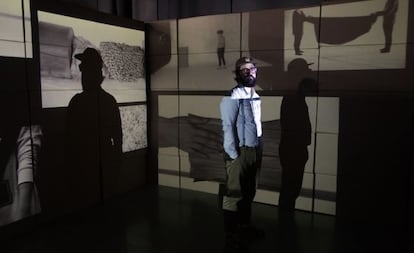Peripheral architecture
Artist Luis Úrculo has created an atlas of eternal actions

Luis Úrculo was searching for a more dramatic dimension to architecture — something involving the narration of space and what happens to it when time becomes part of the equation. It was a 10-year search until he finally completed his architecture studies and found an alternative to the classic concept of the discipline: “Based on gravity, a result, an assessment based on material things,” says this 35-year-old.
Úrculo’s personal path lies on the periphery of that concept, and it was during his studies in Chicago that he finally found his own way. Movies showed him a continuity from the place of “X, Y, Z vectors” he had been taught in school to another place of performance and audiovisual art. And now, this architect-artist has managed to make a name for himself on the international art circuit.
Proof of it is his latest show, Procesos infinitos, an installation currently on at El Ranchito de Matadero Madrid. Úrculo strives to explore the processes and the parts that go into the whole, and which may be created and recreated at different scales and in different settings.
“I was more interested in projects before their execution, and I realized the magic that was being lost… Now my job is to eliminate the final or initial part of things,” he says.
Procesos infinitos began as a research project at a Tokyo artist’s residence. The Matadero show displays 13 out of the 40 images that make up the definitive installation. The looping images depict tasks that get done and undone eternally. “It is an atlas of actions. I always derived great pleasure from watching people doing things, such as in cooking or home improvement shows,” Úrculo explains.
In the looping footage, actions follow one another. One person takes off a sweater, a line of objects pushes one another and hooks up with the first item to start all over again; a cloud appears and disappears “in an eternal composition of something that is going to happen but that nobody will ever see.”
Another part of the Tokyo research focuses on the 5,000 onomatopoeias that the Japanese language uses to represent sounds ranging “from silence to sheen, or water pouring out of a bottle,” in an effort to prove that sound “is a source of information that expands our understanding of space.”
Luis Úrculo. Procesos infinitos. Parte / Atlas. Until January 5 at El Ranchito del Matadero de Madrid. Plaza de Legazpi 8, Madrid. www.mataderomadrid.org
Tu suscripción se está usando en otro dispositivo
¿Quieres añadir otro usuario a tu suscripción?
Si continúas leyendo en este dispositivo, no se podrá leer en el otro.
FlechaTu suscripción se está usando en otro dispositivo y solo puedes acceder a EL PAÍS desde un dispositivo a la vez.
Si quieres compartir tu cuenta, cambia tu suscripción a la modalidad Premium, así podrás añadir otro usuario. Cada uno accederá con su propia cuenta de email, lo que os permitirá personalizar vuestra experiencia en EL PAÍS.
¿Tienes una suscripción de empresa? Accede aquí para contratar más cuentas.
En el caso de no saber quién está usando tu cuenta, te recomendamos cambiar tu contraseña aquí.
Si decides continuar compartiendo tu cuenta, este mensaje se mostrará en tu dispositivo y en el de la otra persona que está usando tu cuenta de forma indefinida, afectando a tu experiencia de lectura. Puedes consultar aquí los términos y condiciones de la suscripción digital.
Últimas noticias
Pinochet’s victims grapple with José Antonio Kast’s rise in Chile
Reinhard Genzel, Nobel laureate in physics: ‘One-minute videos will never give you the truth’
How Japan is trying to avert ‘digital defeat’
The complicated life of Francesca Albanese: A rising figure in Italy but barred from every bank by Trump’s sanctions
Most viewed
- Pablo Escobar’s hippos: A serious environmental problem, 40 years on
- Why we lost the habit of sleeping in two segments and how that changed our sense of time
- Charles Dubouloz, mountaineering star, retires at 36 with a farewell tour inspired by Walter Bonatti
- Trump’s obsession with putting his name on everything is unprecedented in the United States
- The Florida Keys tourist paradise is besieged by immigration agents: ‘We’ve never seen anything like this’








































